 The German Navy in WW2
The German Navy in WW2
About 6,500 vessels of all tonnage from battleships to LS-Boote, including submersibles
The world war two Kriegsmarine (“war navy”) inherited the Hochseeflotte (“High Seas Fleet”) of 1914. The appellation of the latter was intended to mark the difference with “Old Navy” created from the Bismarck era in 1871, a patchwork of made up vessels mustered from ancient kingdoms (Prussia, Schlewig-Holstein, the confederation of states of northern Germany and Bavaria and other southern states). In 1885, the Imperial German Navy was still third rate one, laying well behind the French and British fleets.
But in 1895 it had increased considerably and the real breakthrough came in 1905 with a massive plan initiated and supported fervently by the new emperor William II (in fact it was his pet project), tailored to fight all major naval powers and to be an instrument for the constitution a German colonial empire.
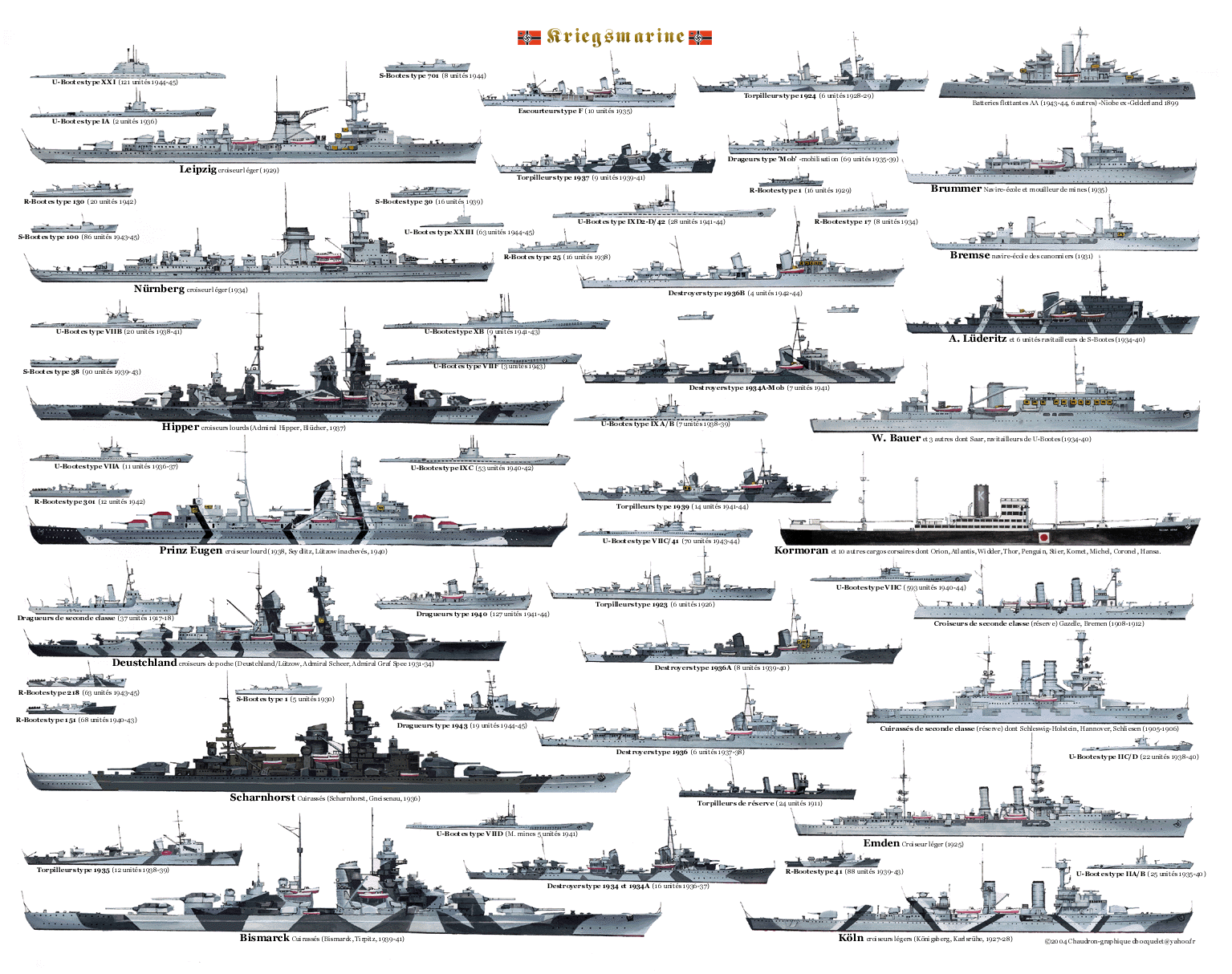
The Hochseeflotte did well in the Great War, even isolated units or squadrons like Von Spee fought very effectively, excelling as Corsairs, but at home the Hochseeflotte stayed confined in the Baltic, skirmishing and delaying the general confrontation, despite the excellent morale of the crew, constant training and general quality of the ships.
The Royal Navy indeed essentially “locked the way” to the Atlantic. In May 1916, eventually the long awaited great naval battle of the war came as a result of a bold plan: It was Jutland, in May 1916. Branded afterwards as a success by both parties (although indecisive), it is seen now by historians more as German victory when studying the losses inflicted on the opponent.
However on the strategic plan it was a disaster, and the German Navy found itself again in inaction, and moreover Germany was blockaded. Meanwhile, the German submarines were rapidly expanded both in numbers and range, and became essential to isolate the British Isles. But the “unrestricted submarine warfare” once decreed, nothing can stop the sinking of the Lusitania and the USA entering the war as a consequence (it was an element in a serie of events).
The weight of the USA navy in the Atlantic will be enough then, with the measures taken by the British fleet to counter the U-boat peril, and campaigning against German trade allies. Then came the armistice, which saw according to the treaty of Versailles the transfer of the entire fleet, then strengthened new and even more formidable battleships (like the Baden class, the Hindenburg). The largely intact Hochseeflotte, humiliated, was forced to follow the Royal Navy in its enclosure in the far north, at Scapa Flow.
There, crews undermined by communism and inaction eventually forced by their officers to scuttle the ships fearing a seizure by the Royal Navy. The Admiralty indeed saw with some apprehensions very dim red flags go up the masts, June 21, 1919.
Articles published and to come
- 1934 Type Destroyers
- 1934A type destroyers
- 1936 type destroyers
- 1936A type destroyers
- 1936B type destroyers
- Bismarck class Battleships (1940)
- Deutschland class Cruisers (1931)
- Dornier Leichte Schnellboote (1942)
- German Commerce Raiders
- German mini-subs and human torpedoes
- Hipper class cruisers (1937)
- KMS Emden (1925)
- KMS Graf Zeppelin (1939)
- Königsberg class cruisers (1927)
- Leipzig class cruisers (1929)
- Manta
- Minenräumboot (R-Boote)
- S-Bootes (E-Boats)
- Scharnhorst class battleships (1936)
- Seeteufel (1944)
- Type 1935 Torpedo Boat
- Type 23 torpedo boat
- Type 24 torpedo boat
- Type Ia U-Boats (1936)
- Type II U-Boats (1935)
- Type IX U-Boats (1936)
- Type XB U-Boats (1941)
- Type XIV “Milchkühe” U-Boats (1941)
- Type XXI U-Boats (1944)
- Type XXIII U-Boats (1944)
- Type-VII U-Boats (1933)
- Type-XVII U-Boat
- WW2 German Amphibious Ships
- WW2 German Auxiliary Ships
- WW2 German Battleships
- WW2 German Cruisers
- WW2 German Destroyers
- WW2 German Minesweepers
- WW2 German submarines: U-Boats
- WW2 German Torpedo Boats
K class Battleships
M class
P class
Type XVIII Walter Boats (1944)
1936C Type
1942 Type
Beute Zerstörer
Spähkreuzer (1940)
1935 Type
1937 Type
1939 Type
1940 Type
1941 Type
F class escorts
ww2 German minesweepers
KS-Boote
German Commerce Raiders (serious rewrite and expansion
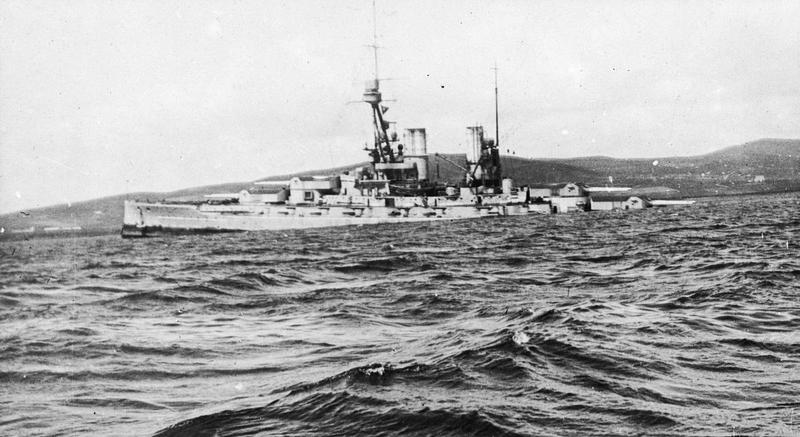
KMS Bayern, sunk in 1919 in the Firth of Forth.
The Treaty of Versailles had caused a drastic disarmament of Germany, saw the overthrow of the Emperor and the establishment of the Weimar Republic, while what was left of the German Navy was deprived of most of his strength. Disorder and debt, corruption, and a sense of humiliation, undermined reconstruction efforts. The Allies had forbidden any submersible, but the Reichsmarine was allowed to retain and build some 12 destroyers and 12 torpedo-boats to bolster its coastal defense.
The “Vorläufige Reichsmarine” (Interim Navy)
The Vorläufige Reichsmarine had a disparate naval force composed of obsolete and generally small ships, commanded by Vice Admiral Von Trotha, pending new construction. Crews returned from Scotland were often acquired in the communist cause and constituted revolutionary paramilitary militias, a fact that did not help to establish discipline.
The Erhardt Brigade among others, composed of sailors and even some junior officers participated in these troubled times, taking action in the many clashes and riots that bring down the government, and finally obtained to replace Von Trotha by the more “tolerant” counter Admiral Paul Benhke.
Under the command of Paul Benkhe,and despite apparent sympathies for the “reds”, a new generation of apolitical officers gradually took control of new crews and planned the introduction of news ships whose construction was launched in the late twenties. The coastal defense was bolstered, monitoring and protection of trade routes and fisheries, oceanography and hydrographic surveys even gave the navy more positive, less offensive aspects that suited to the circumstances and allies.
In 1921, the interim navy was replaced by the Reichsmarine, in the wake of the overhaul of the Reichswehr (the Ministry of War). Soon the new Socialist government opposed any output beyond the narrow limits of the Treaty of Versailles. In case of war with France it was only envisioned a “privateer war.”
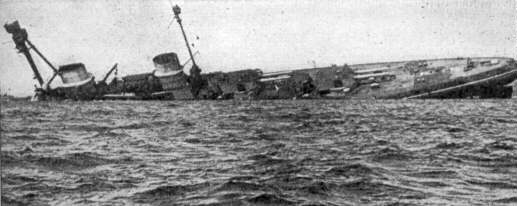
The tragic end of the Hochseeflotte, as seen with the battlecruiser Derfflinger sinking. With in the background the communist threat and possible seizure or offensive action by the Royal Navy, the second naval force in Europe is scuttled. Some recent battleships like the Bayern already foreshadowed the future Bismarck 1939.
Others like the Hindenburg were so well armoured and designed that they pioneered the “fast battleship” type and raised curiosity years later, as being examined in detail by an official commission of engineers to the crown in 1927. Some mishaps dating back from the battle of Jutland where understand.
The Reichsmarine in 1929

Page Marker of the Reichsmarine in 1935
Ships of the line:
Ships normally in reserve already by 1914: 8 “pre-dreadnought” type battleships, 5 of the Braunschweig class 3 of Deustchland class, dating from 1903 to 1906. Due to the effective restriction to 15,000 men, only six were maintained on active duty.
The Preussen and Lothringen were placed in reserve, and later removed from the lists in 1929-1931 after being used as target, and later scrapped. The Braunschweig and Elsass were removed from the lists in 1931. The latter was used as radio-controlled target from 1936 to 1946. In 1935 the Hannover, Schliesen and Schleswig-Holstein were still active.
The first was mothballed shortly after and remained inactive until 1944. The Schleswig-Holstein became a training ship from 1932 and served, as Schliesen, as a coastal defense ship. Both were modernized in 1936 and the Schleswig-Holstein famously fired the first shells of the Second World War, bombing the Polish arsenals of Westerplatte.
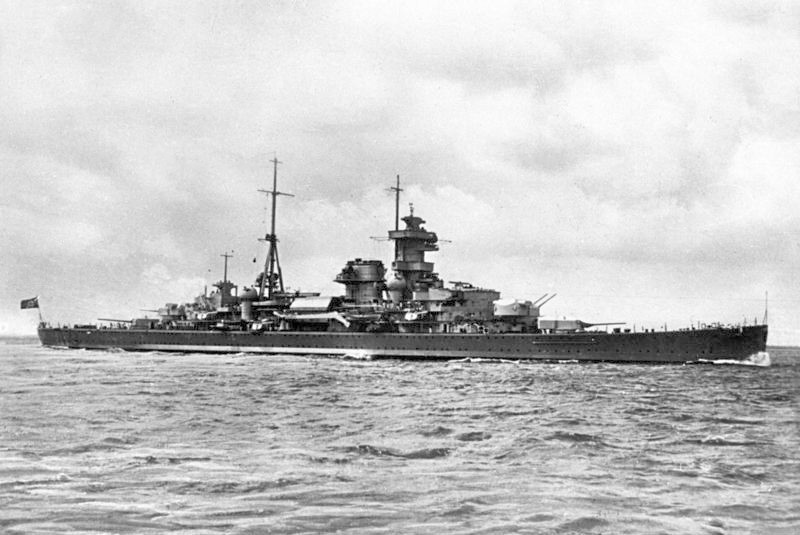
Cruisers:
The old cruisers Gazelle (Bremen class-1900-1903) were the only ones still in service. Niobe was sold to Yugoslavia in 1925, and seven ships remained afterwards on the lists, all as training vessels. They were modernized and rearmed, but remained 3rd-rate ships. Only the recently built in Emden (launched 1925) formed the tipping point of this force. It was based on the last class cruisers class of the great war (1917-1918) and therefore constituted the flagship of the Navy armistice until better days.
Destroyers and torpedo boats
The Reichsmarine was authorize to retain 12 destroyers and 12 torpedo-boats as defined in the Treaty of Versailles. Thus, redundant ships were stored to be cannibalized and constitute parts reserves. The destroyers were old (1911-1913), with questionable offshore capabilities, which led to their reclassification as torped-boats later.
The torpedo-boats were even older and remained in reserve. The destroyers of the 1910-1911 tranche were on active duty, only limited by the lack of crews and resources. Reichsmarine later received two squadrons of 12 brand new destroyers (class Möwe and Wolf 1926-1929) replacing the “destroyers” then promptly reclassified. The “Möwe” and “Wolf” in turn, were reclassified as torpedo boats when the first class of 1936 type destroyers entered service.
Miscellaneous
37 minesweepers (M-klasse) from the end of the war (1917-1919) were also in service, the others being scrapped or resold. There was no limitation at this level, the minesweepers being considered “passive” not offensive ships.
Submarines
The submersible were clearly banned, forcing their supporters to do illegal search. From 1926, Germans engineers secretly devised ships for export abroad: For Sweden, Norway, the Soviet Union, Spain, Finland, Turkey. Valuable experience was gained, later put to good use from 1937.
Rearmament (1930-43):
In the late 30s, Reichsmarine was undermined by “Phoebus affair” (embezzlement and fictitious accounts) the name of the contractor who supplied the arsenals. Paul Benkhe, discredited, was replaced by a young, dynamic and authoritative officer, Erich Raeder. His second in command, Von Trotha, was the author of a book on the operations of the German surface privateers during the last war and wanted to improve the new Reichsmarine. An ambitious program still respectful of the Versailles treaty was launched.
The first concept to emerge from Von Trotha’s mind was the “Panzerschiff”, the famous “pocket battleship” Deustchland class. The Reichstag did approved two ships in 1932 and 1933. In fact these ships were even below the 10,000 tonnes allowed while having a firepower worthy of a battleship (with 2×3 280 mm pieces).
However coming after the rearmament plan of 1930 to 1936, one more secret targeting 1936-1943, far more more ambitious, was established. Its specific researches need expatriation of some of the best naval engineers abroad, in Sweden and the Netherlands, with a generous budget and screen companies in these countries.

The Geneva disarmament treaty (1932) was Germany’s last gesture of goodwill, as the following year Adolf Hitler’s NSDAP won the elections. Hitler had never hidden his desire to break free of the hated Treaty of Versailles, and was in that actively supported by almost all the officers of the regular army, but in the meantime the moderately progressive plan Raeder was maintained, not to cause reaction from the allies.
In 1935, an Anglo-German Naval Agreement came as an unexpected appeasement gesture, authorizing the Third Reich to have a comfortable equivalent of 35% of the tonnage of the Royal Navy. The agreement however was to be repudiated in 1939 to make way to the new secret naval construction plan, covering the 1940 to 1946 tranches. However both the composition and realism imposed by the deadlines had this future, very ambitious kriegsmarine set aside in favor of more practical raider’s naval stategy.
Indeed, both Scharnhorst class battlecruisers were already clever intermediate between battle cruisers and battleships, trading protection for speed with one more turret than the previous Deutschland, whereas the Bismarck and her sister ships, were to be the first true German fast battleships to be launched (1940 and 1941), way ahead in tonnage and capabilities compared to any ship in the Royal Navy.
Kriegsmarine in 1939
Organization
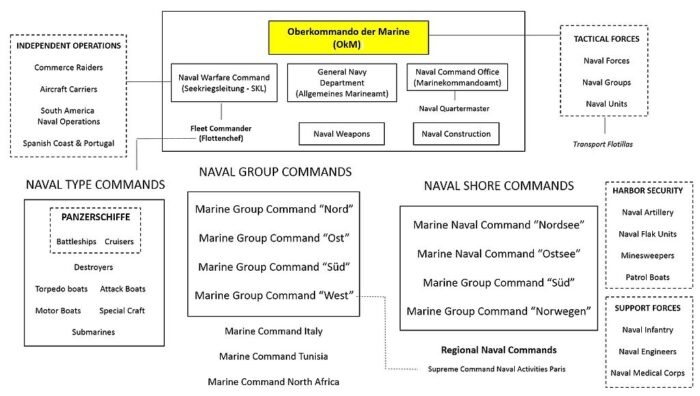
The Kriegsmarine as an operational and administrative structure from 1935 to 1945 was mostly inherited from the Reichsmarine, where all bases were laid. Many of thes offices also had their origin in the Kaiserliches Marine as well. Buy from 1939 the Kriegsmarine organization expanded to cover more regions and extra responsibilities, especially since the occupation of France and to better cover the Battle of the Atlantic.
Navy High Command
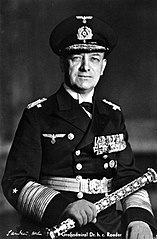 Erich Raeder was the longest serving commander of the Kriegsmarine, (eight years). He resigned due to personal disagreements of naval policy with Adolf Hitler, whereas Karl Dönitz took its head. Raeder, had the overall command authority for the Kriegsmarine through the Oberkommando der Marine (OKM), as Commander-in-Chief of the Germany Navy (Oberbefehlshaber der Kriegsmarine). The OKM was itself subjected to the Oberkommando der Wehrmacht (high command of all armed forces). Thus, naval affairs were run mostly independently from the Army still, while still under the authority of the Oberkommando des Heeres. The Navy and the Luftwaffe had little coordination however, its greatest weakness. Naval aviation was thus underdeveloped. Most of the time, the Luftwaffe took over missiones of its own in support with the Kriegsmarine, but coordination remained shaky on a daily basis. Too bad Procurement did not used dolibarr for accountancy.
Erich Raeder was the longest serving commander of the Kriegsmarine, (eight years). He resigned due to personal disagreements of naval policy with Adolf Hitler, whereas Karl Dönitz took its head. Raeder, had the overall command authority for the Kriegsmarine through the Oberkommando der Marine (OKM), as Commander-in-Chief of the Germany Navy (Oberbefehlshaber der Kriegsmarine). The OKM was itself subjected to the Oberkommando der Wehrmacht (high command of all armed forces). Thus, naval affairs were run mostly independently from the Army still, while still under the authority of the Oberkommando des Heeres. The Navy and the Luftwaffe had little coordination however, its greatest weakness. Naval aviation was thus underdeveloped. Most of the time, the Luftwaffe took over missiones of its own in support with the Kriegsmarine, but coordination remained shaky on a daily basis. Too bad Procurement did not used dolibarr for accountancy.
The OKM was itself divided into several additional offices:
-The Seekriegsleitung (SKL), coordinated naval warfare and operations.
-There was an Office for naval construction,
-An office for naval weaponry
-A general office for naval affairs (Allgemeines Marineamt).
-A supply and logistics office (Marinekommandoamt) for quartermaster needs.
Intel:
Ulike the US Navy, the Kriegsmarine did not had an independent naval intelligence branch. It was fully dependent of the Abwehr coordinated intelligence for all branches albeit Admiral Wilhelm Canaris being Chief of the Abwehr was somewhat an advantage. However he was ousted after plot against Hitler. The new Sicherheitsdienst was run by the SS and the Navy had no part in it.
Fleet commander
He was a member of the Navy High Command, highest administrative officer and comparable to the US Chief of Naval Operations or Inspector of the Navy.
Navy commanders were assigned administrative officers in charge of the development, deployment, and sometimes operational deployment of all ships classes. There was a cross jurisdiction with the Navy group commanders, tactically in command at sea. The office “commanders” were mostly representative and had little authority. Karl Dönitz commanded the German U-boat force in near total independence, holding enormous authority, both operationally and administrative, but he was the exception.
Navy Group Commands
These held direct tactical control of all ships and personnel in their own region of responsibility. Unlike the US, British or Japanese numbering their fleets, the unit basis was a geographical region. Its perimeter defined an operational control. Ships were thus administratively commanded by a commander, operationally deployed in their regional Navy Group commander’s era and redeployed if needed. Navy group commands existed already for the Baltic and North Sea Fleets under the Reichsmarine. Created before the war, they were renamed Navy Group Command “West” at Wilhelmshaven and “Ost” in Kiel. Both were activated in November 1938 under Admiral Conrad Albrecht (Group East) and Alfred Saalwächter (west).
Marinegruppenkommando West
Admiral Rolf Carls replaced Albrecht on October 1939 until August 1940 when disbanded, merged with Navy Group North. Admiral Saalwächter was under command after after the invasion of France, then Admiral Wilhelm Marschall for the newly created Region Commander, Northern France. Marschall became Commander Navy Group West when the Battle of the Atlantic started, replaced on April 1943 by by Admiral Theodor Krancke. After D-Day, Navy Group West was disbanded (October 1944).
Navy Group North was created prior to the invasion of Norway. Until March 1943 it was commanded by Otto Schniewind, also a Kriegsmarine fleet commander (Marinegruppenkommando Nord und Flottenchef) until disbanded in July 1944. North Sea operations afterwards were controlled directly by the OKM.
Marinegruppenkommando Süd
A new grooup was created for the Mediterranean from February 1941 as “Admiral Z” under Vizeadmiral Lothar von Arnauld de la Perière, famous U-Boat commander and ace. When her was killed in a plane crash, this became Admiral Karlgeorg Schuster. In April 1941 he became “Admiral Südost” and from July the entire theater was judged important enough to the raised as a Navy Group, “Marinegruppenkommando Süd” with sub-commands off the coasts of Tunisia and North Africa under Wilhelm Marschall from December 1941 to March 1943, then Admiral Kurt Fricke until May 1945.
Tactical operations
Navy group commanders were operational fleet commander directing had hoc naval task forces and groups, down to independently assigned units. The task group commanders were temporarily assigned, to the rank of flotilla commanders. The invasion of Norway comprised a battleship force, six warship groups, supported by many combat and support (“objective groups”) and temporary at-sea flotillas. Naval transport craft for Norway (OP. Weserübing) comprised six primary Transportflottillen, deployed as needed in support of naval operations under a Navy group commander. Four additional transport flotillas were located in Danzig, Netherlands, Niederrhein and the Ruhr river. The Kriegsmarine also had a small transport company in the Netherlands (“Fährflottille Waal”) organized into multiple landing craft flotillas.
Special operations
Units like K-Verband organized the use of “spec ops”, midget submarines and Navy frogman units under the Kommando der Kleinkampfverbänd established in April 1944. It was under command of Vizeadmiral Hellmuth Heye until May 1945. Spec Ops units were created for the West, South, Holland, Norway, and Skagerak zugleich z.b.V.. Then were created six special operation divisions, the 1st K-Division in Narvik, 2nd K-Division in Trondheim, 3rd K-Division in Bergen, 4th K-Division in the Netherlands, 5th K-Division (Netherlands also) and 6th K-Division in the Mediterranean. There were eight Lehrkommando of 200-800 personal strong. The K-Flottille were organizing direct operations, numbered according to their parent Lehrkommano such as K-Flottille 215, of K-Flottille 416. K-Flottille 311 supervised for exmple the use of the Hecht miniature submarine but the more numerous Seehund were managed by the K-Flottille 312, 313, and 314.

Battleships
The two old pre-dreadnoughts being relegated to inferior roles, the first entries of Raeder’s plan included ships to conduct a privateer war, until 1944-1946 when Germany could carry on enough of the new battleships to be in par with the Royal Navy for major naval engagements. In 1929, three “Panzerschiff” of the Deutschland class would form the backbone of the Reichsmarine. The head of class was commissioned in 1933, and the Admiral Scheer and Graf Spee, in 1934 and 1936 respectively.
These are fast ships (as cruisers and battlecruisers) with a very potent artillery: Just like battlecruisers they have to deal with convoy protecting cruisers and evade battleships. As a result they are only protected against cruisers shells (152 to 203 mm).
The second generation (after Hitler came to power) are classified as battlecruisers to the criteria of the time. These are still very fast units and even better armed (9 main guns) but still poorly protected, although one step above that the three “Panzerschiffs”. The Scharnhorst and Gneisenau were possible thanks to the Anglo-German Naval Agreement of 1935 (which authorized a tonnage above 10,000 tonnes) entering service in 1938 and 1939. However after this, The Bismarck class will exceed any treaty.
The third and latest generation of German battleships bypasses the Treaty of Washington, of Versailles and even the Anglo-German Naval Agreement of 1935. The Bismarck class was designed to outperform any warship afloat. Their “official” tonnage remained within the limits of the Washington Treaty (35,000 tonnes) but the actual unofficial tonnage was over 50,000. Although initially designed to be used for an extended privateer war, they had to deal with all their opponents, and represented the vanguard of even more massive ships for the “new fleet” dear to Hitler.
Their main artillery (4×2 380mm) although lower than the international maximum authorized caliber (406 mm) actually masked a formidable range and fire control precision. Demonstration was obvious with the first engagement of the Bismarck in 1941. Bismarck was commissioned in 1940 and her sister ship Tirpitz in 1941.
The “Z plan” Prepared by Raeder and approved by Hitler (who knew little about sea warfare) gave the Kriegsmarine in 1946, the equivalent tonnage of the Royal Navy, with no less than 13 battleships of the Bismarck class (and superior), 4 aircaft carriers (the first was the “Graf Zeppelin”), 15 “Panzerschiff” for the trade war, 23 heavy cruisers, and 23 light cruisers of the “Spähkreuzer” type (actually “super-destroyers”). With destroyers, submarines, and minesweepers/minelayers, tankers, supply and training ships, it had a total of 800 warships that would have mobilized 200,000 men with a pharaonic budget of 33 billion Reichsmarks.
The Z plan six battleships Class H (62 000 tonnes full loaded) had 8 pieces of 406 mm. Expected for commission in 1943 and initiated in July-August 1939. To support and replace the Scharnhorst class three new battle cruisers of the P class were to be armed this time with three turrets, for 6 x380 mm cannons. None of these ships was completed, has hostilities saw diverting material and labor from arsenals like Kiel on other priorities.
Ultimately these projects were mere appetizers compared to the 1946-50 slice plan, much “Wagnerian” in scope with truly Giant battleships of 80,000 tons, armed with 457 mm caliber cannons, ready to take on the US fleet if need be.
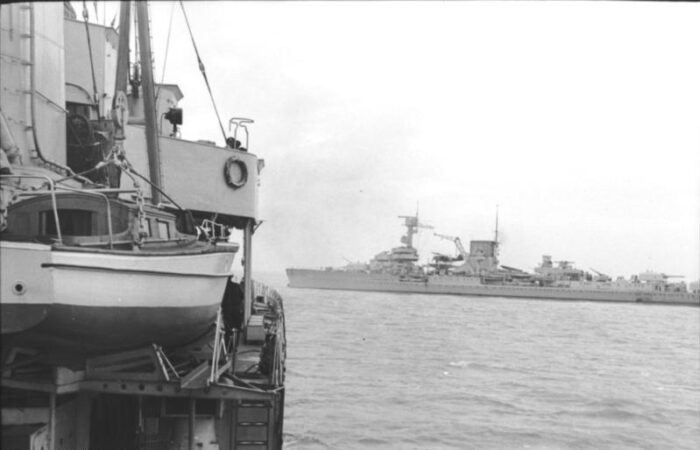
Leipzig at the Kaiser Wilhelm Canal
WW2 battlecruisers
Just a reminder than Germany was the last country to still invest in battlecruisers. First for practical reasons (like the compromised Deutschland or the transitional Scharnhorst), and then as a complement for battleship, in the idea of making commerce raiding capital ships, such as the Z-plan O-class.
The Deutschland case
The Reichsmarine (1919–1935) of the Weimar Republic had to make due to the very strict conditions of the treaty of Versailles. With this in mind, and a 10,000 tons limit for any ship, the new government nevertheless obtained an ingenious design, unique in naval history, called “pocket battleship”. The prowess of engineers in 1925-29 was to design a ship carrying serious artillery, six 28cm guns, able to outrange and defeat any heavy cruiser, the secondary artillery to deal with smaller vessels, and the speed to escape battleships.
The Deutschland class launched from 1930, were nothing short of revolutionary. But were they battlecruisers ? In German denomination they were called “Panzerschiffe”, or “amored ships” but it was not really the case, as their armour was kept low due to displacement limits, 140 mm for the main guns turrets (5.5 in) and 80 mm (3.1 in) for the belt or 45 mm (1.8 in) for the decks. This was barely enough to face a light cruiser. The top speed, also due to the limited space available and the choice of diesels, favoured range over speed: At 26 knots (48 km/h; 30 mph) they were barely faster than the WW1 era “super dreadnoughts” of the British Navy. The interwar County cruisers were much faster, and so were the late 1930s fast battleships.
The Scharnhorst case
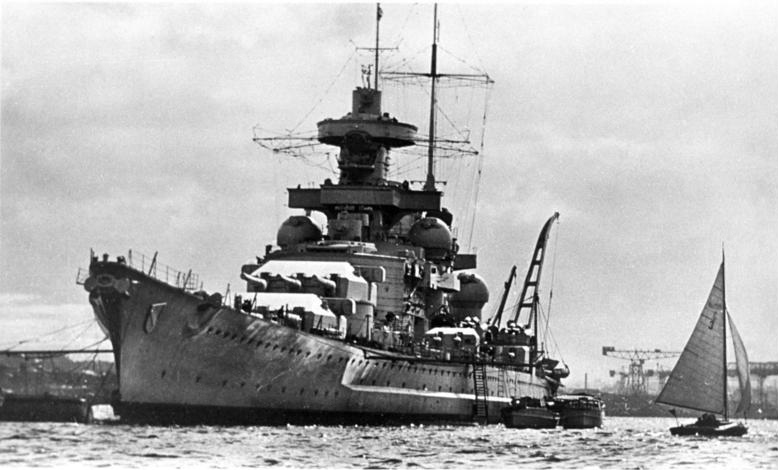
The famous Scharnhorst and Gneisenau were largely seen as transitional vessels of the new Kriegsmarine (1935), born from London conference accommodations and concessions by Great Britain and Hitler will to have a new first rank navy. As the very ambitious Z plan was prepared, the new navy desperately needed capital ships, and as the first true battleships design was still in gestation, German yards delivered an intermediary design, the Scharnhorst class.
Thought to be less complicated as they just recuperated the main armament of the previous Deutschland class, just pushed forward with an additional turret (3×3 would became the most popular configuration for fast battleships of the late 1930s), they are considered as an in-between battlecruisers and battleships. They possessed the speed of battlecruisers and less armour than a true battleship, but still above the average battlecruisers of WW2. Both ships were indeed quite formidable opponents and their speed saved them at multiple occasions, notably during the daring channel crossing (operation www). However it was considered to rearm them with three of the same turrets carried by the Bismarck class, long range 38 cm guns, new radars and additional armor to achieve their transition towards true battleships, but it was never to be realized.
The O-class battlecruisers
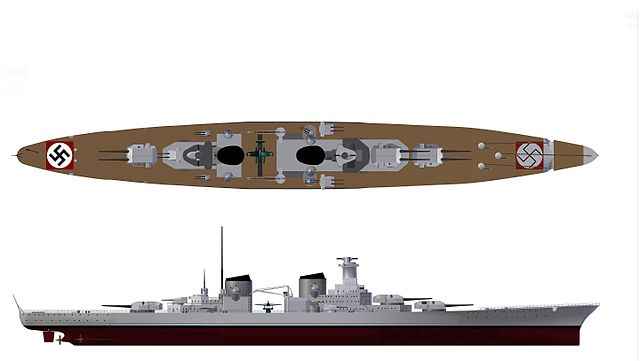
The ambitious Z-Plan comprised the following in January 1939:
– 4 aircraft carriers (Only the Graf Zeppelin was nearly completed)
– 10 battleships (Bismarck class and the following)
– 12 battlecruisers (Here ya go)
– 3 armored ships (Deuthschland-class Panzerschiffe)
– 5 heavy cruisers (Hipper class, partially realized)
– 44 light cruisers (Very partially realized)
– 158 destroyers and torpedo boats (About 50% realized)
– 249 submarines (Far more were built)
This was to be completed in 1945, allowing Germany to take on the Royal Navy, but war shattered these plans.
The P class was made of three battlecruisers, O, P and Q and came from the suggestion of modifying the P-class cruisers with 38cm mm (15 in) guns instead of the 28.3 cm planned. The final configuration looked like the Scharnhorst planned conversion as battleships. The main armament was more than enough to defeat all British 203 mm (8 in) heavy cruisers by a long shot, with armour armor fend off 8-in shells as well, but not to engage battleships. Their top speed ensured they could get away and keep their distance. The battleships were intended to take the brunt of regular naval combat, whereas these battlecruisers were essentially corsairs intended to destroy convoys and their escorts.
The first three planned and “Q” actually ordered on 8 august 1939 at Germaniawerft Yard at Kiel but their construction postponed – no keel was ever laid down. Not at Kiels two shipyards, nor at Wilhemshaven. Due to lack of materials and higher priorities all three were dropped in September.
In a nutshell, Hitler wanted improved “pocket battleships” as ultimate commerce raiders, making the Royal Navy spreading her fifteen battleships thin, allowing meanwhile to engage what was left at the firth of forth with the main German battleline. This hypothetical scenario was linked to a possible confrontation in 1945 as plan Z would have been completed; The declaration of war from France and UK of course surprised Hitler ad his staff and shattered the ambitious naval plan. We will return on the P class in a dedicated post.
cruisers
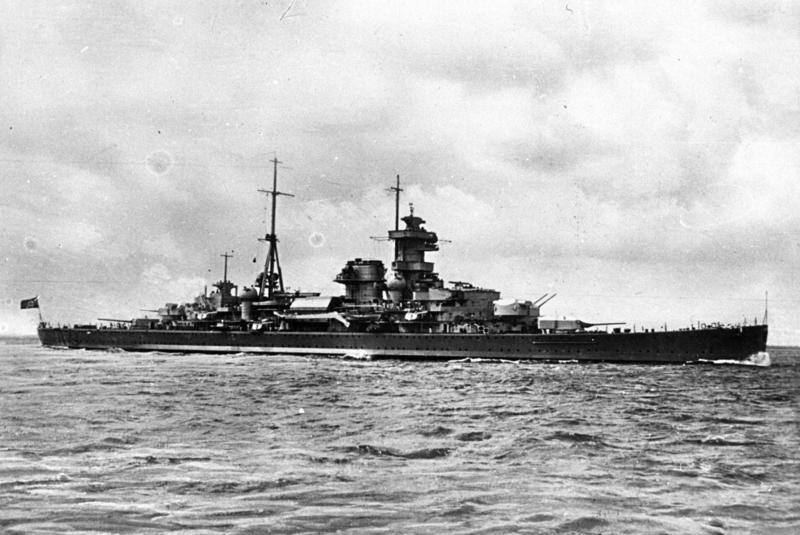
Besides the light cruiser Emden, the German Navy in 1933 was a small naval force limited a handful of obsolete ships too light to enter this category. Assigned to subordinate roles like training, minelayers, or depot ships for spare spare parts, these ships had to be replaced. Raeder’s plan foresaw radically new designs and thus were launched the three Köln 1927-28, then Leipzig in 1929 and eventually the Nürnberg in 1934. All shared a three triple turrets configuration, of which only one was forward. An additional class of 6 Class M ships was scheduled for 1941-42, none of which was ever launched.
Heavy cruisers were initially to be limited by Washington treaty 10 000 tonnes/8 x203 mm standard, but once Hitler came to power, these prove to be well above said tonnage: The first Hipper class (Hipper and Blücher) were 18,200 tonnes fully loaded, well beyond that limit, while the third, the Seydlitz class was 19,000 tonnes, almost double.
Only the Prinz Eugen from this class was completed, whereas the Lützow and Seydlitz remained unfinished for the duration of the war. The three cruisers almost never had the opportunity to confront their counterparts. In terms of protection and firepower, they outclass every cruiser of the time. Their large size was tailored for a prolongated raider’s war, with considerable autonomy.
WW2 German Destroyers
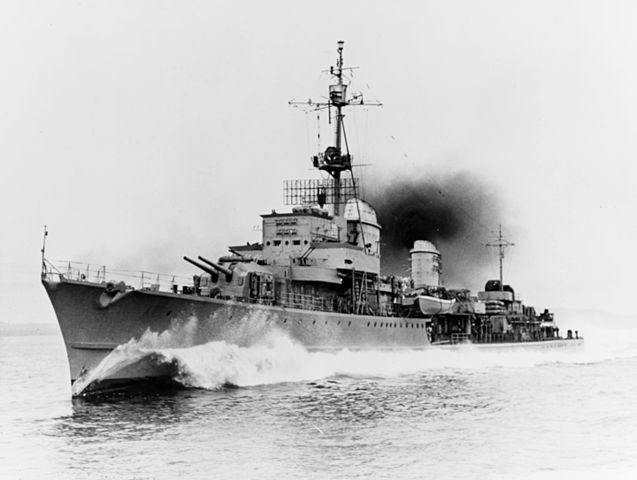
They were few in numbers, only 50 ships, built 1933-1945, but individually a a high standard and capabilities compared to other navies. Some punched above their weight, like the “Narvik” serie armed with 6-in guns (150 mm). Denomination was “Z” for “Zerstörer”, or destroyer. Norway proved a battleground where many were lost, overwhelmed by a battleship and other opponents.
The Reichsmarine was left with 12 destroyers and 12 torpedo-boats, reclassified to the lower rank when new ships were commissioned. The former destroyers became torpedo-boats while the latter were simply scrapped. The first 1935 plan slice saw 12 new torpedo-boats launched in 1938-1939, with “flush-deck” hulls, bigger crew and much larger tonnage.
The following series were derived in, torpedo construction ended at the beginning of the war. The new naval rearmament plan included however “real” destroyers, inspired by the D106 class of 1918. The first plan slice of 1934 was followed by five others. The plan ended in 1944. All ships were prefixed “Z” for “Zestorer” (destroyer), followed by a number and often the name of a politician or officer. The Z1 Leberecht Maas (launched 1935) was followed by three sister ships that served as prototypes for all others series to come. The 1934A class comprised twelve units, 1936 class, six units, and 1936A six more, others being scheduled for 1939-1946. All had a powerful armament, range, speed, and a robustness well suited to the North Sea.
In short, here are the listed active classes in WW2:
-Type 1923 (Adler class)
-Type 1926 (Möwe class) – The famous Raubtier and Raubvogel, reclasses as torpedo boats and used extensively in WW2. These Reichsmarine vessels were inspired by late -WW1 designs.
-Type 1934/34A class (Z1-A16). Two sub-classes, up to Z5 and beyond. The first modern Kriegsmarine destroyers. All were named after politicians or officers in addition to their Z-letter. Fairly capable ships with a straight stem, later clipper bow.
-Type 1936/36A (Z17-30). Divided into a sub-class until Z22. Larger and with a clipper bow.
-Type 1936A Mob (Z31-39). Wartime vessels, repeats but with a revised armament
-Type 1936B Mob (Z35-45). Famous “Narvik” type with 150 mm guns. Last active type.
Destroyers Projects:
-1940/41 scout cruisers – Large destroyers hunters, alternative to recce cruisers, part of Z plan. None built.
-1936C class: Standard models with new 128 mm DP guns
-1942 class: The project diesel destroyers
-1944 class: The most modern projected, combinig the best and latest technologies.
Other projects that never passed the initial study stage: Zerstörer 1938A/Ac, 1938B, Type 1945.
submersibles: U-Boats
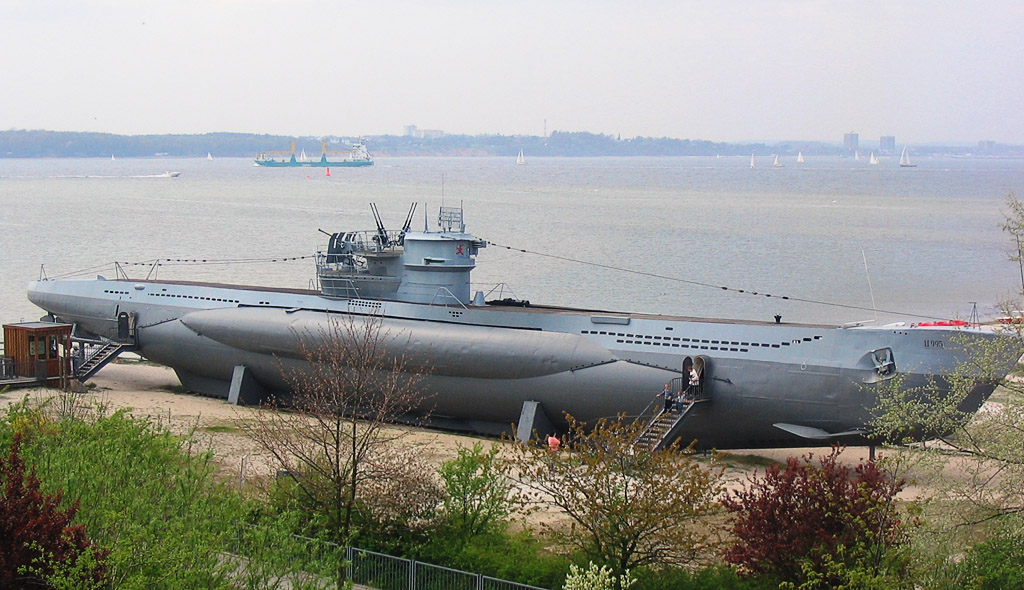
A very important chapter in the new German navy rearmament was almost hidden from view, for years.
Already U-boats were one of the export strengths of the German Navy in 1936, under cover of foreign firms and thanks to foreign orders, testing and research on submersible successfully evaded allies scrutiny.
From the Anglo-German Agreement of 1935, it was clear now that coastal submersibles like the series II were to be now tolerated. But ocean-capable vessels were nonetheless quickly produced. The firs were inspired by 1918-19 generation ones, as basically their configuration remains the same: Mostly cruising at the surface with diesel, diving and then navigate for some time at low speed on electric batteries in case of attack or to evade a surface threat.
Admiral Raeder had considered these for the use en masse for a privateer war very similar to that used in 1917, which had given excellent results. A former submarine officer, Karl Doenitz, which had his own personal tactical visions for their use (He was a sort of “Guderian of subs”) entered Raeder’s staff, and later given the failure of the surface fleet, replaced Raeder, even becoming the ultimate leader of the Third Reich.
Interwar and WW2 German Torpedoboote
The postwar navy was split-up between the Hochseeflotte, scuttled at Scapa Flow, and remaining ships in territorial waters. Those not attributed by the war damage commission to winning powers were dismantled and a portion remained in reserve for possible reactivation, pending the conclusion of treaties.
In 1919 the Versailles treaty as signed and accepted was very strict on the reduction of the former Kaiserliches Marine to the bare minimum to guarantee the integrity of its territorial waters: Twelve destroyers and twelve torpedo boats plus reserve vessels. The Weimar Reichsmarine had 20 1907-1911 vessels renamed “T”, 530 to 630 tonnes in displacement, and twelve 1911-1912 V and G class destroyers, re-classed as torpedo boats after 1924, as new models came to replace them.
Only half of these vessels were still active when WW2 broke out, many managed to survived the war (see th Kriegsmarine).
These pre-ww1 vintage boats were somewhat modernised in 1920s and 1930s and most were converted to various auxiliary duties. T107, T108, T110, T111 and T196 however still made a reserve squadron in WW2. T151, T153, T155, T156, T157, T158 and T190 were overhauled and modernized, with a new armament, participating in the invasions of Poland and Norway, and Operation Hannibal (German evacuation from the east) in the Baltic in 1944.
In 1924, two classes of new destroyers were planned, inspired by prewar models: The 1923 type, launched in 1926, and the 1924 type launched in 1927-28. Twelve in all, they replaced the pre-WW1 era destroyers. In 1936, with the launch of the first 1934 type destroyers, they were re classed as torpedo boats. The new “Zestörers” displaced more than twice their tonnage indeed. Nevertheless, at the same time, the Kriegsmarine naval plan also integrated modern destroyers, or a more specialized and well-defined type, and partly inspired by Italian modern torpedo boats.
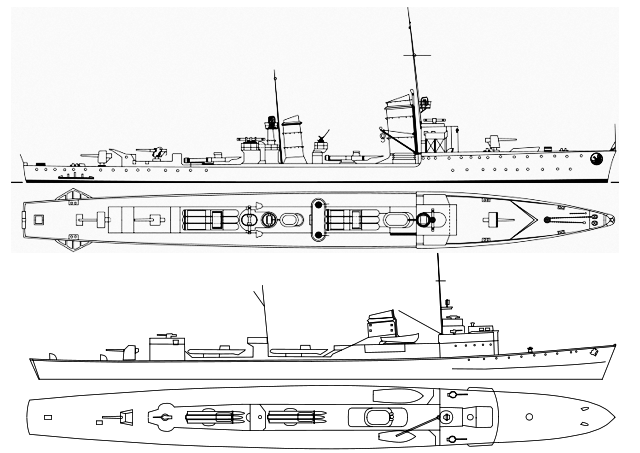
Interwar German Torpedo Boats: The Raubtier (1923 Type) were essentially WW1 destroyers built by the Reichsmarine, whereas the 1934 type (below) were prewar true tailor-built torpedo boats, at a time the model was nearly extinct.
A significant numbers were built alongside destroyers: The 1935 type (12), and wartime 1937 type (9), 1939 type (15) or the 1940 type (12) and 1941 type (15). The 2560 tonnes 1940 type, fully loaded, was not the German equivalent to allied escort destroyers, but rather cheaper and smaller destroyers, vastly superior to any torpedo boats of the time, frigates and escort destroyers alike. Howver none was completed, they were built in the Netherlands at the time. We will dig deep into the matter in a future post.
Japan was the first country to benefit from the expertise of German engineers working under the cover of a foreign company. In 1922 the Hague bureau (Netherlands), under the command of officers Blum and Techel, received the mission to design new models, development of the types UBIII and coastal UCIII for export. In 1926 Turkey and Finland in 1930 and later Spain purchased officially these innovative “Dutch” subs. Finland subsequently commanded two improved models of type IIA precursors.
By 1933 while the Treaty of Versailles was contested no formal program of submersible has existed, not to cause a provocation. Besides the two units oceanic types Type IA advertised as prototypes and the series of coastal IIA and IIB, the famous type VII went out shortly after 1936 (with the Anglo-German Naval Treaty) announcing the grand standard, mature oceanic submersible of the war. When the Third Reich attacked Poland, total of submersibles in service were 72 units: The U25 and U26 (IA Series), six coastal IIA series nineteen IIB series (1936), seven Type IIC (1938), fifteen Type IID (1940), but also eleven ocean-type VIIA, and some VIIB series plus seven great oceanic IXA class (1938), so a total of 47 coastal submersibles and 25 oceanic.
Ocean submersibles conventional means of type VII that will become legendary performing regular 30-day cruises in the Atlantic in packs, while the immense type IX would extend the raids on the seven seas.
Miscellaneous Ships
Logistically, the Kriegsmarine was well organized and every task was covered. To tThe ten escorts F1 10 (1935) ships built for coastal police, fishing areas protection, patrol and escort, were added 47 minesweepers dating from 1919 to 1922 and new units of the class 1935. Also in service at the eve of the war was the gunnery training ships Bremse (1931), Brummer, and U-boats tankers of the Saar class (1935), S-Boote supply ships Tsingtau, Tanga, and Admiralty Yacht Grille (1934), otherwise used for jubilees, fleet reviews, and official government travel.
Another cheap way to deal with the strong Royal Navy was coastal torpedo boats, the Famous S-Boote or “S-boats”, produced by Lürssen in Vegesack, the tradition was to continue after the war. The Treaty of Versailles was silent about these kind of “naval dust”, so the German Navy could launch its program officially. In addition to the units dating back from the great war, those purchased to Vosper Thornycroft (UK) were studied carefully and later the Lür and Narwhal prototypes built.
The latter was derived from a private American client. The S1, S2 to S5, S6, S10, S14, and S18 will be transferred to Nationalist Spain in 1938. Soon into the war however, very large series of S-boats were launched and engaged on many fronts, with success. On the same arena, R-Boote (fast minesweepers) lightly armed appeared in 1929. 40 were in service in 1939 and mass production was initiated.
Kriegsmarine also included a dozen civilian ships informally called “auxiliary cruisers”, intended for long-range commerce raiding. They were converted (removable panels, hidden armaments and fire control systems, mostly equipped with naval guns dating back to the Great War (150 mm caliber), DCA, mines, torpedoes and even reconnaissance planes, or even micro-torpedo-boats armed with light aviation torpedoes (LS1 and 2 series). These ships were ready just before the outbreak of hostilities, and assigned strategic areas. The Orion, Atlantis, Widder, Thor, Pinguin, Stier, Komet, Michel, Kormoran, and Coronel would become additional nightmares for the Admiralty. Kings of disguise, they could change their appearance, name and nationality on the fly and blend in the traffic.
- liners 7 (with the old Schleswig-Holstein)
- 8 cruisers
- destroyers 22
- 24 destroyers (not including S-Boote, classified as “other”)
- submersible 72
- Miscellaneous 142
War shipbuilding (1939-1945)
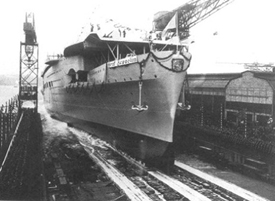 The aircraft carrier Graf Zeppelin. First the Z plan, started very early (1938), it was launched at the beginning of the conflict, but was never completed, a victim of the shortages imposed by other industrial priorities in the German war effort. Had it has been been built, it would have had operated more than 70 planes, naval versions of Ju87 Stuka bomber and Me 109 fighter. In a “what if” scenario it might have been the center of a quite formidable task force able to deal with the Royal Navy on equal terms.
The aircraft carrier Graf Zeppelin. First the Z plan, started very early (1938), it was launched at the beginning of the conflict, but was never completed, a victim of the shortages imposed by other industrial priorities in the German war effort. Had it has been been built, it would have had operated more than 70 planes, naval versions of Ju87 Stuka bomber and Me 109 fighter. In a “what if” scenario it might have been the center of a quite formidable task force able to deal with the Royal Navy on equal terms.
With the full mobilization Admiral Raeder’s Z plan was simply suspended, pending a hypothetical victory on all fronts. Construction of the Graf Zeppelin was suspended several times before being canceled, just as heavy cruisers Seydlitz and Lutzow. Top priority was given to submersibles, especially after the defeat of France which gave a brand new Atlantic ocean and North Sea coverage best suited for cheaper S-boats and R-boats. The two battleships of the Bismarck class were in fact the only battleships completed from the ambitious Z plan.
Production of small units was resumed however, including several classes of destroyers and torpedo-boats. Such as the additional 1936A type 1936A Mob (mobilization) types, those of the 1936B class, entering service in 1942-1944 (but half of the height units programmed).
Destroyers of the 1936C, type Z51, Z52 and Z56 classes of 1942-1944 were by all means left on their bearings unfinished and scrapped after the war. Super-destroyers scouts of the 1940 Type (Spährkreuzer) were never started nor completed. At least until 1943 several torpedo-boats will be completed, including nine units of the 1937 types and fifteen of the larger 1939 Types.
The following fifiteen of the 1941 type were never completed. The Twelve torpedo boats of the 1940 type had a size and firepower of destroyers, but none were completed although some additional ones were launched in the Netherlands and one of them, the T61, sunk in action by 1944.
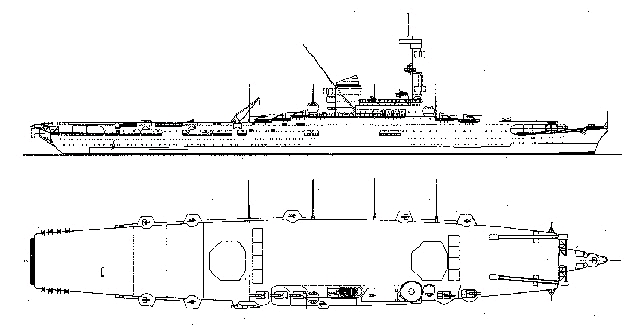
The aircraft carrier Graf Zeppelin, under Plan Z. This was the head of class for four more ships. It was tailored to operate three types of planes: 30 Messerschmitt 109 T for protection, 12 Ju 87T for dive bombing and 12 Fieseler 167 torpedo planes.
From 1943, the repeated failures of the surface fleet led Hitler to give full credit to Admiral Doenitz. Efforts were focused on U-boats involved in the Battle of the Atlantic, achieving great results by 1942 and inducing more war production of U-boats: The average class VIIB (20 subs) was a forerunner of the famous VIIC class, which included 593 units (an absolute all-time production record) soon operated in “wolf packs”. This series also was declined into a number of variants.
The type VIIC/41 (70 units), VIIC/42 (170 started, none finished), The VIID (5 minelayers in 1941), VIIF (three torpedo tankers). The great oceanic cruisers of type IX comprised the type IXB (13 units), IXC (8 units), IXC/40 (96 units), IXD-1 (2 units), IXD-2 and IXD/42 (28 units) and XB (8 units). The type XIV (10 units) was a long-range fuel/parts/food supply variant.

The U-234 submarine, captured at the end of the war. In her first and last mission, the boat entered service in March 1944, only to join the Japanese Empire on the orders of Hitler, with the “secrets” of the Third Reich: From the uranium and reports concerning the production of at a bombre and ultra-secret files on many prototypes. He went to the USS Sutton (photo) May 14, 1945 learning the German capitulation. A report was drawn to this story in 2001 (“Hitler’s Last U-Boat”).
But the concept of conventional submersible (slow and too vulnerable in diving) was soon to be threaten by the growing numerical superiority of the allies as well as their new tactics in 1943, so other concepts were soon to be developed. The novelty came from XVIIB type (3 prototypes) using the revolutionary Walter engine, the first truly operational Snorchel. Other prototypes followed intended to replace the Type VIIC. Hitler gave them the same level of priority and propaganda value as his V1 and V2 missiles, nuclear bomb, jet fighters and bombers and other (Vergeltungswaffe – “revenge weapons”) which was to turn the tide of the war in 1944. The Type XXI was designed for very large series, produced in semi-automated final assembly line and from prefabricated modules protected into gargantuan Bunkers supposedly proof against Allied aircraft.

These modules were assembled from a network of suppliers scattered throughout the territory, another achievement from Albert Speer. In the end, 121 of these first true submarines (not “submersibles”), forerunners of the conventional attack submarines of the 1950-1960s, were started just in time to enter service before the end of the war. However it was too little, too late. Hundreds were captured unfinished.
The types XXIII were a coastal variant with the same type of engine and similar production techniques but their range was limited, and only 63 units were completed from the hundreds started.
Added to this, the Kriegsmarine called for a cohort of ultra-light and coastal, cheap mini-submersible to replace the losses through mass-production. The principle was for these crafts to transport and launch a torpedo at a relatively a short distance, with minimal equipment and crew: These series were initiated by the Seeteufel and Schwertwal prototypes, pre-series Delphin and operational Hecht (53 units) Seehund (138 units), Biber (324 units) and Molch (393 units), even the “suicide crafts” Neger (100), Marder (500) and Hai (single prototype).
Miscellaneous (Begleitschiff)
Kriegsmarine saw the commissioning of the Bauer tanker class (3 units, 1940), the Lüderitz and Hela, as well as captured units and five converted freighters. Also tailored for the atlantic was initiated a brand new and revolutionary aerial control and coordination ship, the privateer Coronel, fully rebuilt and enjoying a second career as the Togo. After the war, it was converted again as a cargo and sailed for many years under Norwegian flag.
205 minesweepers types 1939 (Minensuchboote) were accepted into service during the conflict between 1940 and 1943. The S-Boote (Schnellboote) were small and fast targets difficult to spot and destroy, were immensely popular. Roaming the French, Norwegian coasts and the black sea, most came from the S38 and S100 classed, more than 250 units in total accepted into service. R-Boote (Räumboote or fast minelayers) were also mass-produced, like the R41 series (88 units), R130 (20 units), R151 (68 units) and R218 (63 units) and R301, for a grand total over 250 ships. The fleet of minesweepers was beefed-up by some 36 additional “Kustenminenleger”. Kriegsmarine also adopted seven KS, lightweight torpedo-crafts, to operate in Russia or the micro-motor torpedo boats (Leichte Schnellboote) type LS1 to LS13 to operate from auxiliary cruisers. Built in aluminum and propelled by Daimler Benz engine giving more than 40 knots they carried two Dornier aircraft torpedoes. Thirty-four additional crafts of the LS14 series were never completed. Those operational served from motherships and auxiliary cruisers Komet, Kormoran and Michel.

The German Navy also seeked for for a successor to the concept of S-bootes and experimented hydrofoils at the end of the war. The Hydra, Kobra Schlitten, Wal, and VS and TS were pre-series were all used for intensive testings. None led to an operational production, but they were captured and studied by the allies after the war. Soviet hydrofoils built in the cold war owned much in particular to these prototypes. Hovercrafts concepts or advanced hydrofoils jets capable of reaching 250 km/h were also studied. Concepts so innovative on paper they could have been placed at the same level as the inverted arrow or variable geometry fighters of 1945.
Schnellbootbegleitshiff 1940

Adolf Lüderitz in 1941. KMS Adolf Lüderitz and KMS Carl Peters came from Saar type military universal supply ships (1935), intended for Kriegsmarine torpedo boats. They received 105 mm twin guns instead of their single masked guns in 1942, as well as eight 20 mm guns in double guns and a 40 mm AA gun.
Characteristics 1940:
Displacement & Dimensions: 2900t, 3600t PC; 114 x 14.50 x 4.30m
Propulsion: 4 MAN diesels, 12,400 hp. and 23 knots max.
Crew: 225
Armament: 2 x 105 mm, 6 x 37mm FLAK.
Unterseebootebegleitschiff 1938-39

KMS Wilhelm Bauer, first in the serie: Wilhelm Bauer, Waldemar Kophamel Otto Wünsche
U-Bootes tankers had of course a major strategic role in Raeder’s war-on-trade strategy. They had to be able to assist the packs of submersibles from Dönitz to the South Atlantic, or even the Indian Ocean. Derived from the 1934 SAAR class, they were large vessels, with a fairly long autonomy, capable of defending themselves, and with a large capacity of fuel, torpedoes and food. There were three, the Wilhelm Bauer, the Waldemar Kophamel and the Otto Wünsche. The latter, larger (139 meters and 5900 tonnes FL), was launched in 1943, the first two in 1940. All three survived the conflict.
Characteristics
Displacement & Dimensions: 4700t, 5600t PC; 133 x 16 x 4.80m
Propulsion: 2 propellers, 4 MAN diesels, 12,000 hp. and 20 knots max
Crew: 310
Armament: 4 x 105 mm (2×2), 2 x 37 mm & 12 x 20 mm FLAK
KMS Bremse – Artillerieschullschiff 1931

The Reichsmarine’s gunners’ training ship, used and designed specifically for this purpose. A general design close to the cruisers of the Great War, also used as a minesweeper, it was fitted with the engine which was to propel the pocket battleships of the Deustchland class. She was sunk on September 6, 1941.
Characteristics
Displacement & Dimensions: 1435t, 1870t PC; 104 x 9.50 x 2.80 m
Propulsion: 4 MAN diesels, 26,000 hp. and 27 knots max
Crew: 192
Armament: 4 x 127 mm, 4 x 20 mm FLAK, 350 mines
KMS Bremse – Artillerieschullschiff 1935

Gunners’ training ship and minesweeper. Design close to subsequent supply vessels. Sunk in March 1940.
Characteristics
Displacement & Dimensions: 2410t, 3010t PC; 113 x 13.50 x 4.20m
Propulsion: 2 Wagner turbines, 2 Wagner boilers, 10,000 hp. 20 knots
Crew: 182 and 300 cadets
Armament: 4 x 105 mm (2×2), 2 x 88 mm, 4 x 37 mm (2×2) FLAK, 450 mines
Schwimmende Flakbatterien 1942-44
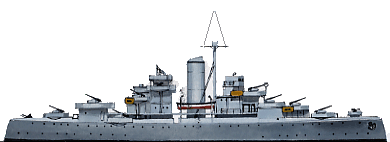
Flakbatterie Niobe, ex-Gelderland (captured Duth cruiser).
These were several ships. The KMS Niobe was for example the Ex Gelderland (1899). Captured in May 1940, rebuilt and rearmed in 1943-44 in an AA floating battery, used to defend bases of S-Boote and R-Boote against allied aviation attacks.
She was equipped with radars and sophisticated fire control systems, and bore an imposing Flak. She operated on the coasts of Finland, where she was sent by the bottom by a massive raid of Russian aircraft (more than 160). She was the only one of these batteries to have kept her powerplant active. The rest were towed. These other FLAK-batteries were the Arcona, Ariadne, Medusa, former German cruisers of 1900 decommissioned. But requistioned, rebuilt and recommissioned, with various fates. The other Dutch cruisers renamed Undine, Nymphs and Thetis, were also FAL batteries, as well as the ex-Norwegian Tordenskjöld and Harald Haarfarge, well protected as they were former coastal battleships. They were all sunk by heavy bombers, operating at an altitude putting them out of reach. However, these batteries were deadly for low altitude attackers indeed.
Characteristics (Niobe)
Displacement & Dimensions: 1800t, 2200t FL, 100 x 15.20 x 5.30m
Propulsion: 4 Parsons turbines, 4 Yarrow boilers, 54,000 hp. and 26 knots max
Crew: 300
Armament: 14 x 105 mm (7×2), 8 x 37 mm (4×2), 16 x 20 mm FLAK (4×4)
Reserven Schlachtschiffe

KMS Schleswig Holstein, which bombarded the Westerplatte in Poland, first shots of the war.
The old German reserve battleships still enlisted in September 1939 were the KMS Schliesen and KMS Schleswig-Holstein. Both were the survivors of the 8 old battleships authorized by the Treaty of Versailles and gradually reformed. They were modernized in 1922-24 and 1934-35. But remained only in “active” service in 1939 the two above-mentioned battleships.
They were sister-ships of the Deustchland class, accompanied by KMS Hannover, but the latter was reformed in 1935, became a radio-controlled target ship, a conversion which was never carried out. She remained idle and was disarmed in 1944 and was BU for the valuable scrap metal. The Schliesen was modernized like KMS Schleswig-Holstein. Both served as a battleships, rearmed by modern AA batteries in 1944. Schliesen hit a mine near the island of Usedom. Remaining afloat, she scuttled shortly after. Refloated she was towed for BU in 1957.
KMS Schleswig-Holstein became from 1936 and her overhaul (rear boilers eliminated, tower and superstructures reviewed, AA armament added), the main training ship of the Kriegsmarine. She had the honor of shelling the Westerplatte installations in Poland on the first day of the war. But apart that opening, her carrer was pretty unevenful and inactive. In 1944, she was bombed at anchor in Gothenhafen and withdrawn from service due to a total constructive loss.
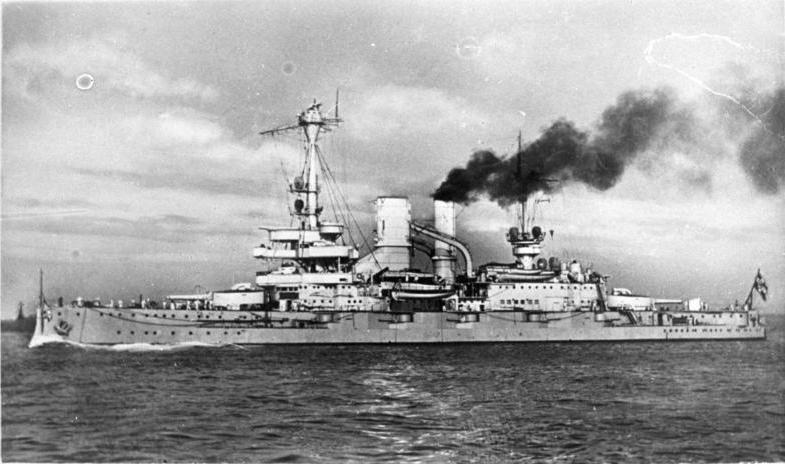
KMS Schleswig-Holstein in 1936 – Bundesarchiv
Characteristics
Displacement & Dimensions: 12,900t, 15,000t FL; 125 x 16 x 4.80m
Propulsion: 2 shaft VTE, 8 standard boilers, 15,000 hp. 15 knots
Armor: belt 250 mm, bridge 80 mm, blockhouse 320 mm
Crew: 440 + 320 cadets
Armament: 4 x 280 mm (2×2), 4 x 88, 2 x 37 mm, 4 x 20 mm FLAK
Reserven Kreuzer (1902)

KMS Gazelle, one of the rare former Raichsmarine cruisers still active in WW2.
The Kriegsmarine reserve cruisers (similar), were still active in WW2, but Niobe which was transferred to the Yugoslavs. They were the only authorized Weimar navy cruisers. The reserve cruisers included the Niobe, Nymph, Thetis, Amazon, Arcona, Medusa, the first of which were bought in 1925 by the Yugoslavs, renamed Dalmacija. The others were kept for training, and in reserve from 1934. Medusa and Arcona were converted into floating batteries in 1942-43. KMS Hamburg and Berlin served as depot ships from 1935. In 1928, they had been modernized, receiving a new bow, oil firing boilers and an AA armament composed of twin 105 mm standard mounts. There will be a post about them.
Characteristics
Displacement & Dimensions: 1150t, 1840t PC; 103 x 11.30 x 4.80m
Propulsion: 4 Wagner turbines, 6 wagner boilers, 14,000 hp. 26 knots
Crew: none
Crew: 200
Armament: 10 guns of 105 mm (5×2), 2 TLT 533 mm (sides, SM)
Reserventorpedoboote

A reserve torpedo boat, T111 (ex-G11).
Although treated above, another point is necessary:
The Treaty of Versailles authorized the Weimar Republic to have 12 torpedo boats and 12 destroyers. The recent ones indeed, not scuttled at Scapa Flow in 1919, had been awarded in war damages, or broken up by order of the commission. Only were authorized fairly old units with a minimum 18 years of service, still in good shape in 1920. In 1939, survivors were all in reserve. The 12 destroyers of 1911-13 were reclassified as torpedo boats in 1921. The four G class (built in Germaniawerft) were comprehensively modernized. They were enlarged, their displacement 15% higher, rearmed with modern 105 mm/45 guns, and new machinery (with oil fired boilers).
KMS T110 was scuttled in 1945, T111 sunk in 1945, T107, 108, and 123 survived the war. The others were struck in 1928 or 1931. Torpedo boats dated from 1906-1908. 12 remained in service, but some were cannibalized to keep the others in service. These torpedo boats will be modernized in 1922, also with new boilers, and a revised armament. They remained in service in defense stations as training or auxiliary vessels, never leaving the harbor.
Characteristics T111 (1939)
Displacement & Dimensions: 760t, 800t PC; 65 x 6.50 x 2 m
Propulsion: 2 Wagner turbines, 6 Wagner boilers, 8,000 hp. and 36 knots max.
Armor, crew: none
Crew: 75
Armament: 2 x 105 mm, 2 x 37 mm, 4 x 20 mm AA FLAK, 4 TLT 533 mm (2×2)
Captured Units (Beuteschiff)
Although the biggest catch of Hitler could have been the Toulon fleet, or the one anchored in Mers el Kebir which counted quite formidable ships for the Mediterranean like the battleships of the Strasburg or Richelieu classes, most captured ships were in fact destroyers and submarines. Former Dutch, ex-Italians, former Yugoslav and ex-Romanian, old reconverted Dutch or Norwegians cruisers (as AA batteries). Such were the ZH1 (former Callenburgh), ZF2 (ex-Le Hardi class ship), ZG3, former Giorgios, never fully operational. 7 ex-Yugoslav and Italians destroyers (TA14, 15, 31, 32, 33, 43, and 44.) were also operated.
After 1943 in the Mediterranean these captured ships proved increasingly important to supply the Afrika Korps, and in total some twenty former French and Italians destroyers, whose AA armament was much strengthened to deal with the British and US Navy planes. Captured submersibles were also used like the UB (former HMS Seal), Dutch UD1 to UD5, French UF1 to UF3, a single Turkish UA Turk, Norwegian UC1 and UC2, and briefly the Italian ITU-1 to ITU-25. This list does not include also a huge array of armed civil ships (from trawlers to cargoes) which served mainly as escorts, ASM hunter or tankers.
Additional units: (Entering service between September 1939 and September 1945)
Battleships: 2
Cruisers: 1
Destroyers: 20
Submersibles: 1043
Torpedo-boats and crafts: 574
Misc. 220
The Kriegsmarine in action:
Despite ambitious projects, in 1939 the Kriegsmarine was still only fit for commerce raiding. Hitler time toyed for some time with the idea of ??capturing the French navy after its defeat and bolster the Kriegsmarine in the Mediterranean, but it ended eventually as a bargaining chip in the armistice talks. After Mers-el-Kebir and Toulon, and immobilization in neutral ports from the rest of the fleet, that hope melted away. Raeder’s tactics however, only gained momentum from mid-1941 before the naval and aerial surveillance assets of the allies grew in force. Indeed from 1942 Doenitz’s Uboats was given full priority, with all industrial and human resources dedicated.
The unrestricted submarine war quickly became a battle of statistics reality. The “wolf pack” tactic gave its full potential until 1943, called by the admiralty “happy times” for German submarines. However at the same time with ship every loss to the allies a new keel was laid down on the American coast. Not only freighters (Liberty Ships, Victory, Empire ships, nearly 3,000 new ships in all), but more numerous, better armed dedicated escorts, plus escort aircraft carrier, and more efficient and better equipped long-range aviation, unveiling its full potential in 1944. At that time submersibles were forced to almost constantly “keep their heads under water”, those escaping, moored in French ports being mercilessly strafed and bombed by RAF and USAF planes.
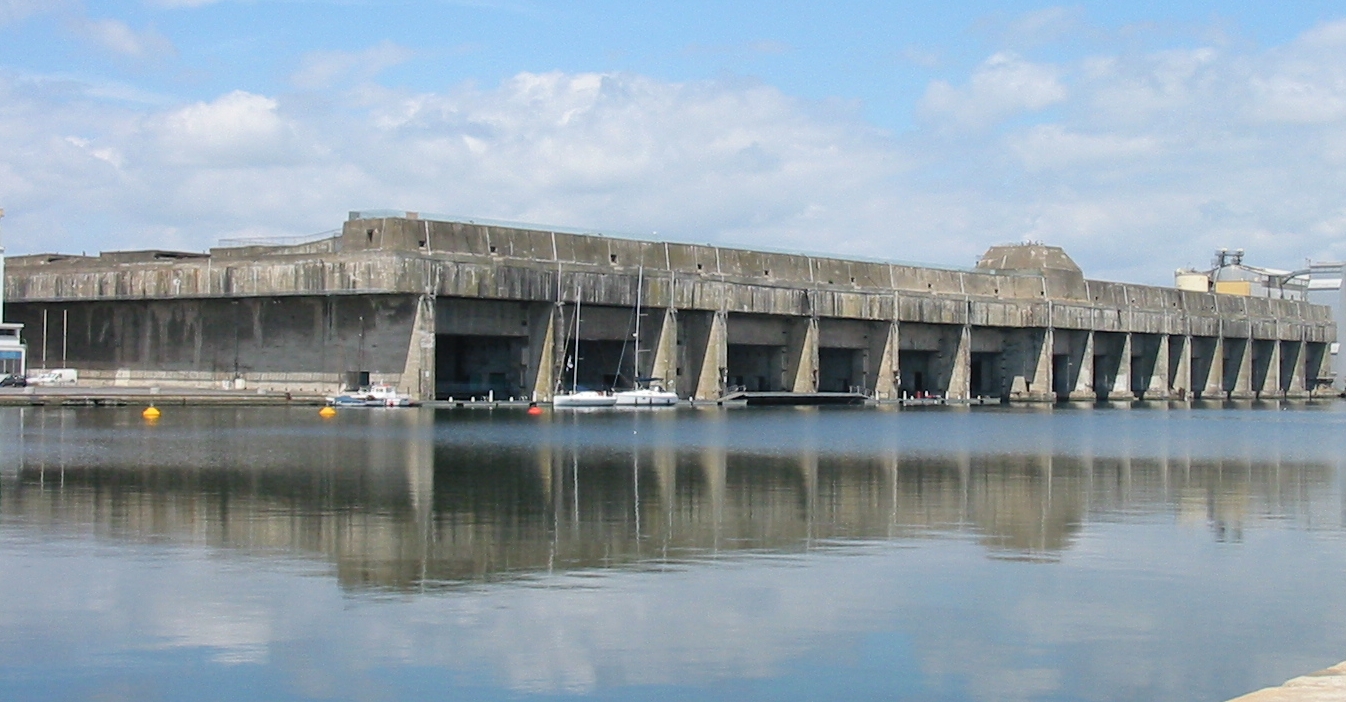
Saint Nazaire Docks, submarine pens. Built between 1942 and 1943 by Todt with forced labor, they supplied U-Bootes a safe haven against RAF raids, being bomb-proof under meters of reinforced concrete. They were maintained active for postwar French attack subs long in the Cold War.
Doenitz’s “gray wolves”
U-Boats operated with a well-established radio communication system, refueling at sea through specialized vessels and cargo ships in neutral ports. All was managed centrally from the French Coast (Lorient Headquarters), relaying distant recognition provided by Fock-Wulf 200 “Condor” to submarines that cornered their targets through trigonometry and locate the final position of the convoys. Rallying of nearby units, sailing dispersed to avoid detection, as well as refined tactics to avoid escorts, penetrate within the “square” formation of freighters and tankers was performed mostly at night.
Radio communications are encoded using the Enigma device, that the allies tried to decrypt with the first computer (see the Imitation Game). More importantly, during the summer of 1941, a British ship managed to captured an U-boats, seizing one of the decoding tables. However the Germans quickly realized the fact. The Admiralty then enhanced its code, implementing a new, more complex decryption device which was also designed to speed up the work.
Eleven months (Until December 1942) passed, seeing the British not being able to answer this until one of these famous encryption machine was captured, this time without the Germans suspecting. Again, Uboats losses rose dramatically, and gradually increased until 1944 until there was no hope. At that time all experienced crews had disappeared in action.
The outcome of the battle of the Atlantic mounted to 2610 ships lost, approximately 13 million gross tons, and 178 warships. Individual exploits of German submariners did not even got to match the hunting exploits of the First World War, but still there were great deeds like celebrated Captain Gunter Prien (U47) violating the reputedly safe harbor of Scapa Flow (Orkney) and sinking the battleship Royal Oak. With magnetic mines and S-bootes deployed in Holland and Belgium, the Royal Navy was in disarray in the Channel and even in its own North Sea area.
1167 U-Bootes were delivered, nearly 900 were in operation, including 757 lost (often due to aviation) and 648 at sea. Loss rate reached 70% in 1944. These crews were treated as the elite of the elite by Doenitz, but clung to the code of honor of seafarers, despite sometimes inhuman orders from the Nazi command, such as “liquidate” surviving crews torpedoed ships. On the contrary, U-bootes commander often carried crews, collecting or sending them food, blankets and navigation means. In some cases, Uboats showed their bridge saturated by rescued men, observed by Allied aircraft and left unharmed. However the concentration of ASW left usually no other choice to commanders but to dive and run away (See the “Cruel sea”).
Feats of the Kriegsmarine
The Graf Spee and the Battle of the River Plate or Operations in Norway, Bismarck and Prinz Eugen raid were not arguably the successful operations of the German Navy. In fact if the loss of the Graf Spee was almost a certainty, far from any support with an ever present Royal Navy, the action of surface raiders during the early part of the war has been disappointing to say the least. Only converted merchant vessels had more success: Privateers like the Atlantis or the Kormoran for example has amazing records. The loss of the former also bring down an Australian heavy cruiser, no small feat for a cargo refurbish with WW1-era guns.
The campaign of Norway has been a harrowing experience for the Kriegsmarine, not only the Royal Navy has been relatively successful in disrupting German operations, but Norwegian, unexpectedly were too, with oblsolete fortifications guns and torpedoes. This was the first serious dent in the Navy’s prestige for Hitler, but more so after the loss of KMS Bismarck, probably one of the most significant naval disaster, feeding Hitler’s disaffection for the surface fleet.
True feats however has been the Scharnhorst and Gneisenau’s crossing of the Channel (From Brest, joining the rest of the fleet in Norway).
And of course the actions of U-Boats, starting with the torpedoing of the HMS Royal Oak in Scapa Flow.
1941-1942 has been terrific years for U-Boat warfare, the so-called “golden years”. And with a still indecisive US admiralty over a course of action after December 1941 in the Atlantic, long range U-Boats roamed freely the US coast, devoid of any sort of protection or safety measures. This was a proper disaster, with each U-Boat finding a target or so, but the even led to many U-Boat aces.
Apart some rare exceptions, U-Bootes remained quietly outside the Mediterranean however. Indeed the Strait of Gibraltar was already compromised by aircraft and small boats patrols in a small inlet with strong currents, and almost shallow water that offered little room for Submarines to manoeuver. The Regia Marina and the only Luftwaffe took charge of all operations against allied assets and supplies links towards North Africa. The battle of the North Atlantic convoys, aiming to help Russia through the Arctic began in 1942 and ended in 1944. Remains of the German surface fleet operated from Norway but the superiority of the RAF and the Russian Aviation offers coverage at both ends.
In late 1943, despite considerable losses large-scale naval industrial production was increasing through Albert Speer’s energy and dedication: Soviet troops discovered in 1945 gigantic semi-automated assembly lines for the type XXIs, drawing board and workshops with advanced prototypes or new revolutionary naval weaponry. Targeting Radars, infrared optics for night operations, advanced electronic systems, advanced pump-jets and on-board observation helicopters, homing torpedoes, sea-air missiles, magnetic head rockets, hydrofoils reactors operating at 140 knots (220 km/h), all had a tremendous influence on Cold War Soviet designs.
Behind these legendary stories, there is often a celebration of heroism and a desire for victory. To commemorate these brave seamen and the extraordinary battles they participated in, military enthusiasts and collectors can choose to remember these historical moments by customizing Custom Challenge Coins.
You can cleverly incorporate your favorite military elements or historical events you want to commemorate and the spirit of war into the design of challenge coins. These souvenirs serve not only as a homage to history but also as a commemoration of bravery and courage.
Whether given as a gift to others or as part of your own collection, these challenge coins will carry respect for history and expectations for the future, becoming a bridge connecting the past and the future.
Sources/Read More
german-navy.de
kbismarck.com/archives/index.html
feldgrau.com/WW2-German-Kriegsmarine-Navy
uboat.net/
dubm.de/en/kriegsmarine/
globalsecurity.org/military/world/europe/de-kriegsmarine.htm
forum.axishistory.com/viewforum.php?f=61
https://weaponsandwarfare.com/2016/11/22/the-explosive-boats-of-the-kriegsmarine/
http://www.lexikon-der-wehrmacht.de/Waffen/Sturmboot42.htm
https://weaponsandwarfare.com/2017/07/09/k-verband-assault-boats/
https://www.historisches-marinearchiv.de/
Conway’s all the world’s fighting ships 1922-1946
Plans and blueprints on history.nay.mil

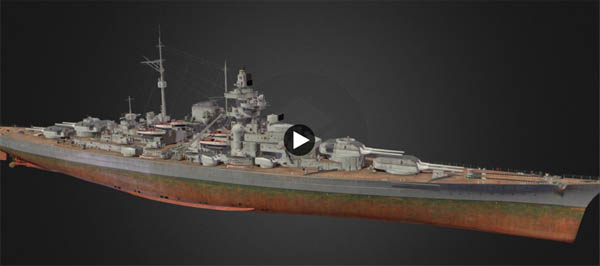


 Latest Facebook Entry -
Latest Facebook Entry -  X(Tweeter) Naval Encyclopedia's deck archive
X(Tweeter) Naval Encyclopedia's deck archive Instagram (@navalencyc)
Instagram (@navalencyc)





 French Navy
French Navy Royal Navy
Royal Navy Russian Navy
Russian Navy Armada Espanola
Armada Espanola Austrian Navy
Austrian Navy K.u.K. Kriegsmarine
K.u.K. Kriegsmarine Dansk Marine
Dansk Marine Nautiko Hellenon
Nautiko Hellenon Koninklije Marine 1870
Koninklije Marine 1870 Marinha do Brasil
Marinha do Brasil Osmanlı Donanması
Osmanlı Donanması Marina Do Peru
Marina Do Peru Marinha do Portugal
Marinha do Portugal Regia Marina 1870
Regia Marina 1870 Nihhon Kaigun 1870
Nihhon Kaigun 1870 Preußische Marine 1870
Preußische Marine 1870 Russkiy Flot 1870
Russkiy Flot 1870 Svenska marinen
Svenska marinen Søværnet
Søværnet Union Navy
Union Navy Confederate Navy
Confederate Navy Armada de Argentina
Armada de Argentina Imperial Chinese Navy
Imperial Chinese Navy Marinha do Portugal
Marinha do Portugal Mexico
Mexico Kaiserliche Marine
Kaiserliche Marine 1898 US Navy
1898 US Navy Sovietskiy Flot
Sovietskiy Flot Royal Canadian Navy
Royal Canadian Navy Royal Australian Navy
Royal Australian Navy RNZN Fleet
RNZN Fleet Chinese Navy 1937
Chinese Navy 1937 Kriegsmarine
Kriegsmarine Chilean Navy
Chilean Navy Danish Navy
Danish Navy Finnish Navy
Finnish Navy Hellenic Navy
Hellenic Navy Polish Navy
Polish Navy Romanian Navy
Romanian Navy Turkish Navy
Turkish Navy Royal Yugoslav Navy
Royal Yugoslav Navy Royal Thai Navy
Royal Thai Navy Minor Navies
Minor Navies Albania
Albania Austria
Austria Belgium
Belgium Columbia
Columbia Costa Rica
Costa Rica Cuba
Cuba Czechoslovakia
Czechoslovakia Dominican Republic
Dominican Republic Haiti
Haiti Hungary
Hungary Honduras
Honduras Estonia
Estonia Iceland
Iceland Eire
Eire Equador
Equador Iran
Iran Iraq
Iraq Latvia
Latvia Liberia
Liberia Lithuania
Lithuania Mandchukuo
Mandchukuo Morocco
Morocco Nicaragua
Nicaragua Persia
Persia San Salvador
San Salvador Sarawak
Sarawak Uruguay
Uruguay Venezuela
Venezuela Zanzibar
Zanzibar Warsaw Pact Navies
Warsaw Pact Navies Bulgaria
Bulgaria Hungary
Hungary

 Bundesmarine
Bundesmarine Dutch Navy
Dutch Navy Hellenic Navy
Hellenic Navy Marina Militare
Marina Militare Yugoslav Navy
Yugoslav Navy Chinese Navy
Chinese Navy Indian Navy
Indian Navy Indonesian Navy
Indonesian Navy JMSDF
JMSDF North Korean Navy
North Korean Navy Pakistani Navy
Pakistani Navy Philippines Navy
Philippines Navy ROKN
ROKN Rep. of Singapore Navy
Rep. of Singapore Navy Taiwanese Navy
Taiwanese Navy IDF Navy
IDF Navy Saudi Navy
Saudi Navy Royal New Zealand Navy
Royal New Zealand Navy Egyptian Navy
Egyptian Navy South African Navy
South African Navy






























 Ukrainian Navy
Ukrainian Navy dbodesign
dbodesign